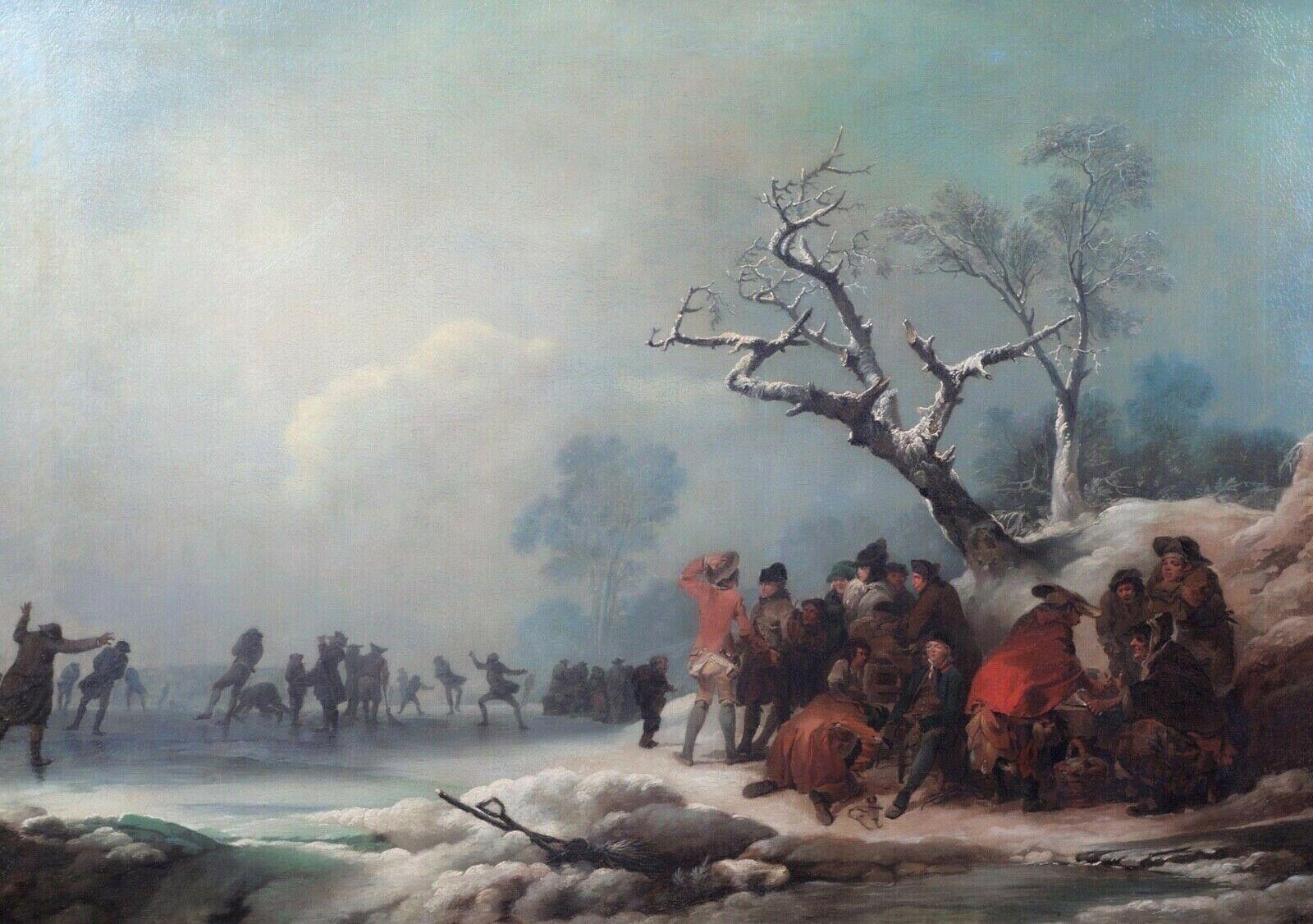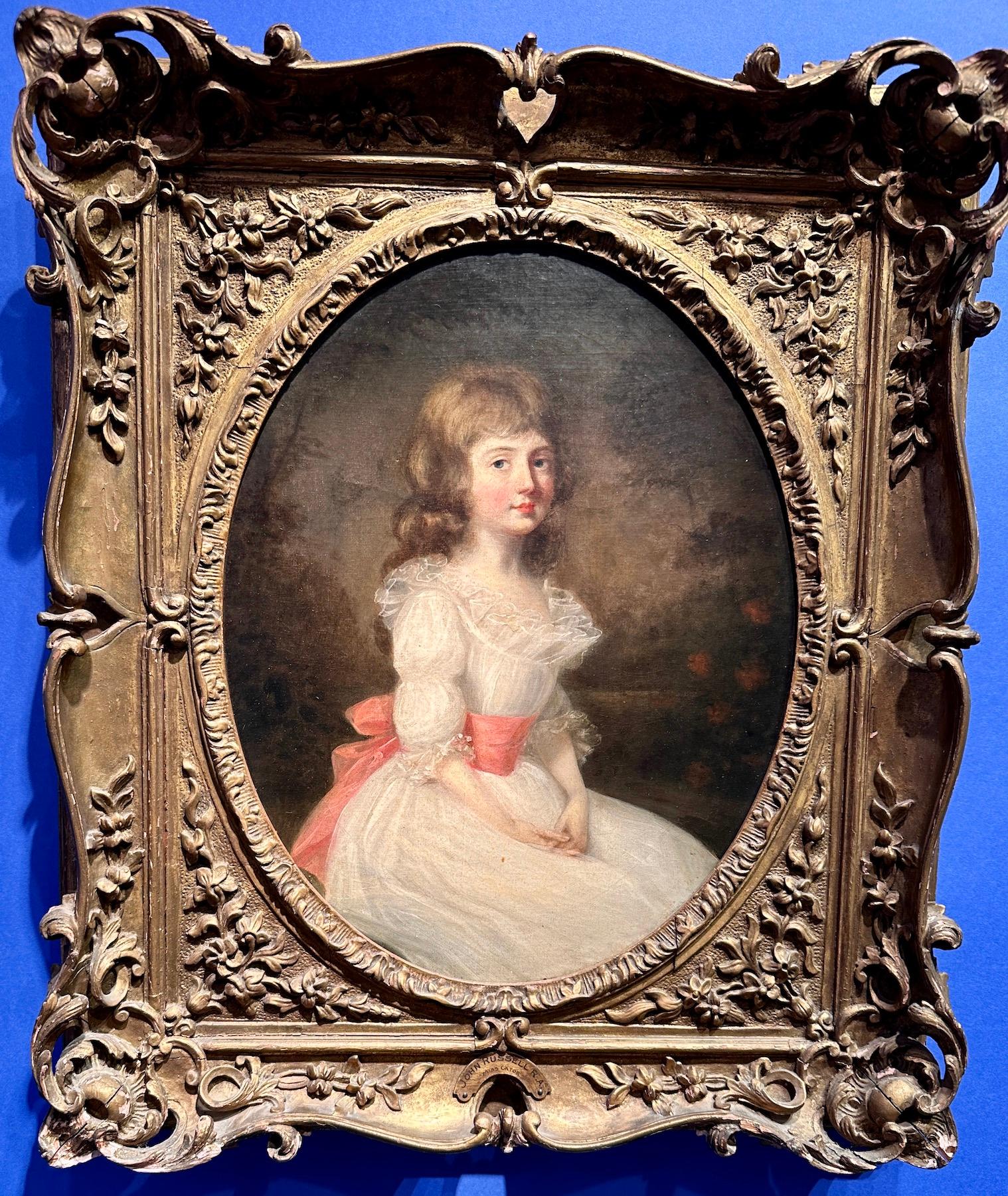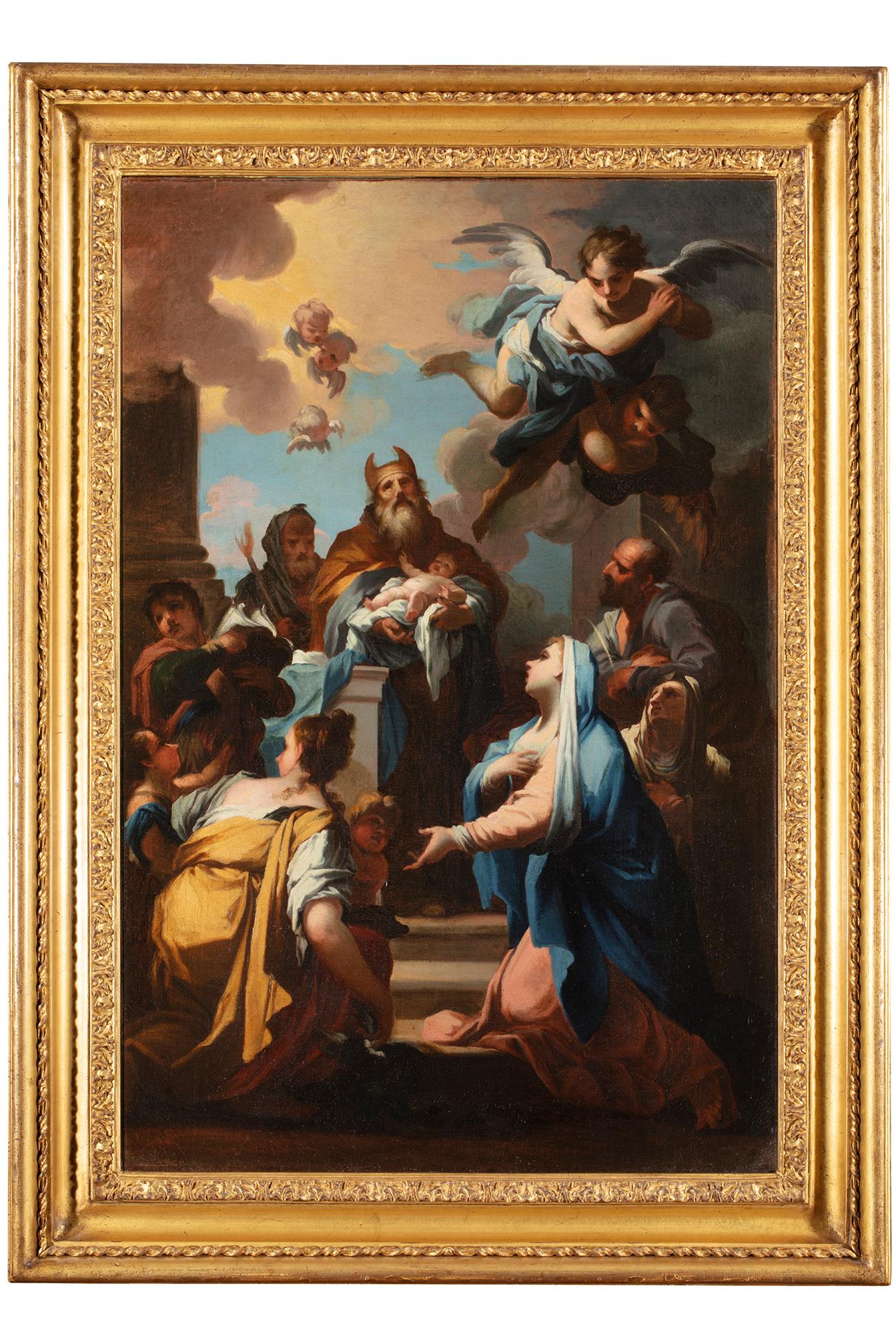Items Similar to Jean-Marc Nattier (1685 - 1766) - Portrait of Charlotte de Hesse-Rheinfels
Want more images or videos?
Request additional images or videos from the seller
1 of 12
Jean-Marc NattierJean-Marc Nattier (1685 - 1766) - Portrait of Charlotte de Hesse-Rheinfels
About the Item
Jean-Marc Nattier (Paris, 1685 - 1766) and his workshop
Portrait of Charlotte de Hesse-Rheinfels
Oil on canvas : h. 44.09 in, w. 38.19 in
18th century carved giltwood framed
Framed : h. 52.36 in, w. 47.63 in
Charlotte de Hesse-Rheinfels (1714-1741), daughter of Landgrave Ernest-Léopold de Hesse-Rheinfels-Rotenburg and Éléonore de Lowenstein-Wertheim and Kazazyan, was Princess of Condé by her marriage in 1728 to Duke Louis-Henri de Bourbon-Condé known as Monsieur le Duc.
The princess is portrayed seated on a canopy of gilded wood trimmed with raspberry red velvet, the body positioned facing forward while the face is turned three-quarters to the left. The face with a thoughtful and thoughtful gaze is awakened by its large gray eyes, the translucent skin with painted cheeks accentuates the effect of a melted execution of the model. Her powdered and tied hair is adorned with an orange veil which goes down on her shoulders. The separation fades between the powdered hair and the face. Dressed in a golden yellow satin dress embellished with multiple rows of white and black lace flounces at the bodice and sleeves, the neckline of her dress reveals her bare throat. The ermine coat lined with blue velvet is placed behind his shoulders, the sides of the coat come back to the front and are arranged in angular folds on his knees. With her right hand, arm bent at the elbow, she caresses her little dog, while the left arm resting on the armrest of the armchair is extended and the index finger of her open hand points to the right. The positions of the arms and the head generate an illusion of diagonal movement allowing to break the static character of portrait. This stretching of the arms horizontally is characteristic of Nattier's works, the figure thus grows in size in the painting by occupying a larger place there. This process carried out by highlighting the elegance of refined gestures increases the natural grace of the young woman. The sober architectural background is composed of a column draped with a green curtain and flattened pilasters with Ionian capitals. The light coming from the right partially illuminates the figure, leaving the left part in shadow. Illuminated, the young woman's dress reflects golden reflections in warm orange tones, while the velvet of the coat broken into angular folds reveals its surface through icy white ridges. This opposition only accentuates the volumes and textures of the fabrics. The facial features under a subtle effect of blurred appear more softened while the pearly white complexions seem illuminated with an inner radiance.
Related works:
Our work is a variant of the painting executed by Jean Marc Nattier, kept at the Museum of Fine Arts in Buenos Aires, Argentina. Signed and dated, but the illegible date makes it impossible to establish a precise dating.
In our version, the dress with a lace corset is preferred to the negligee of the Buenos Aires version, the console is absent. The little dog with the red bow is added on the knees.
The Condés are the first blood princes among Jean Marc Nattier's clients. He began to work in 1729 for the sisters of Louis Henri de Bourbon, Mlle de Clermont and subsequently painted the portrait of Mlle de Charolais in 1731. It is very likely that it was during this period, delighted by the quality of the portraits of his sisters, that the Prince of Condé commissioned the portrait of his wife Charlotte from Nattier. Requested in the 1740s by the royal family, Jean Marc Nattier returned to paint the Condés again in 1753 & 1754.
There are no traces of the signed portrait of Buenos Aires in the inventories of the Condé family. Its known provenance dates back only to the middle of the 20th century.
Regarding our portrait, it appeared in 1905 in Paris in a public sale auction during the dispersal of the collection of the account of R… without further indications on its internal provenance. Undoubtedly remaining on the Parisian art market, the painting was purchased in the 1930s by a wealthy English industrialist for his Monegasque residence and is remained in his posterity until nowdays.
Jean-Marc Nattier (Paris, 1685 - 1766)
Son of a portrait painter and pupil of Rigaud, Nattier began his career as a history painter under the influence of Charles Le Brun and under the tutelage of his godfather, Jean Jouvenet . During a stay in Holland, he was approached to work for Tsar Peter the Great. In 1718, he was received into the Academy. His style is then that of the great French tradition. He uses the resources of the architectural setting and the grandiloquent expression of the characters; its chromaticism is frank. But Nattier does not know success; his ruin at the time of Law's bankruptcy forced him to turn to the more lucrative genre of portraiture. In 1728, he painted the Marshal of Saxe to order and enjoyed a certain favor from then on. It is, at more than forty years, the beginning of a new career which asserts itself with the Portrait of Mlle de Clermont taking the waters (1729). By the choice of subject as by the pictorial means, he established a new way of presenting the portrait, in which the high society of the middle of the 18th century wanted to recognize itself, which had the favor of the great amateurs of the 19th century . century. Elegance of the pose, freshness and clarity of the color, fantasy of the rendering of the accessories add to the serene and joyful expression of the female faces. Superficial works, but pleasing to the eye. The type of mythological portrait is now adopted by the ladies of the aristocracy and Nattier knows Parisian success for a dozen years. Later, received at court, he became the portrait painter of the royal family. The famous series of portraits of the daughters of Louis XV is part of an effort to recreate the portrait by integrating a topical image into the poetic world of Olympus. Nattier thus joins the paths of history painting, speculative and synthetic: the universe recreated in the portraits (such as that of Madame Henriette in Flore) joins the noble data of the allegory.
- Creator:Jean-Marc Nattier (1685 - 1766, French)
- Dimensions:Height: 52.36 in (133 cm)Width: 47.63 in (120.99 cm)
- Medium:
- Movement & Style:
- Period:1730-1739
- Condition:Very good original condition, cleaned and revarnished by our professionnal art restorer.
- Gallery Location:PARIS, FR
- Reference Number:1stDibs: LU2433214036452
About the Seller
No Reviews Yet
Vetted Seller
These experienced sellers undergo a comprehensive evaluation by our team of in-house experts.
1stDibs seller since 2023
7 sales on 1stDibs
Typical response time: 1 hour
- ShippingRetrieving quote...Ships From: PARIS, France
- Return PolicyA return for this item may be initiated within 3 days of delivery.
More From This SellerView All
- A 17th c. Italian school, Capriccio with the Colosseum, circle of V. CodazziLocated in PARIS, FRA capriccio with the Colosseum in Roma 17th century Italian school Circle of Viviano Codazzi (1604-1670) Oil on canvas Dimensions: h. 35.43 in, w. 51.18 in Modern 17th century style ...Category
17th Century Old Masters Landscape Paintings
MaterialsCanvas, Oil
- Late 17th century portrait of a French princess, daughter of Louis XIVBy Pierre GobertLocated in PARIS, FRPortrait of Françoise Marie de Bourbon, Duchess of Orléans as Venus A magnificent painting depicting the princess in all the splendour of her youth, Françoise Marie de Bourbon, known as the second Mademoiselle de Blois (Maintenon, 1677 - Paris, 1749), daughter of Louis XIV and Madame Montespan, future wife of the Regent. Late 17th century, circa 1695 Pierre Gobert (Fontainebleau, 1662-Paris, 1744) and his workshop Oil on canvas Dimensions: h. 109 cm, w. 92 cm (42.91 in x 36.22 in) Important 19th century Louis XIV style giltwood and gilt stucco stucco finely carved with foliage and scrolls. Framed dimensions: h. 142 cm (55.9 inch), w. 126 cm (49.61 inch) The princess is portrayed full-length seated on a chariot pulled by two doves floating in the sky. Her slender face is draped in an ample antique blue dress...Category
Late 17th Century Old Masters Figurative Paintings
MaterialsCanvas, Oil
- Louis XIV and his army at the crossing of the Rhine by Adam-Frans van der MeulenBy Adam Frans van der MeulenLocated in PARIS, FRAdam-Frans van der Meulen (Bruxelles, 1632 - Paris, 1690) Louis XIV and his army at the crossing of the Rhine 12 June 1672 Signed A.F VANDERMEULEN at the right low corner Oil on can...Category
1670s Old Masters Landscape Paintings
MaterialsCanvas, Oil
- Nicolas de Largillière - Portrait of a Lady, Paris, circa 1695By Nicolas de LargillièreLocated in PARIS, FRNicolas de Largillière (Paris, 1656-1746) Portrait of a lady, circa 1695 Oil on canvas (relined): 76 x 61 cm Framed: h. 97 cm, l. 82 cm To be included in the forthcoming catalogue ra...Category
1690s Old Masters Figurative Paintings
MaterialsCanvas, Oil
- Rest on the Flight into Egypt - Attributed to Pieter Van Avont - 17th c. FlemishBy Pieter van AvontLocated in PARIS, FRRest during the Flight into Egypt - The Virgin and Child with St. John the Baptist and the angels in a Landscape. Attributed to Pieter Van Avont (1600-1652) 17th century Antwerp School, circa 1630 Oil on oak panel, Dimensions: h. 38 cm, w. 50 cm (14.96 in x 19.68 in) Flemish style frame in ebonized and moulded wood Framed: h. 56 cm, w. 68.5 cm (22.04 in. x 26.97 in.) In the heart of a lush wooded landscape, the Virgin with Jesus rests in a green clearing accompanied by Saint John the Baptist and the cherubs. Seated to the left of the composition, the Virgin Mary holds the Child on her lap; the little Saint John the Baptist wearing the camel-skin tunic (his attribute) stands before Jesus to exchange a few caresses. On the right, the couple of cherubs are playing with the lamb of Saint John the Baptist, bringing a jovial character to the scene. A pair of gardening putti on the left pick flowers to bring bouquets to the Virgin and Jesus. Spring flowers such as tulips, daffodils and anemones that grow abundantly around them and enrich the composition with their shimmering colors. A lush rose bush blooms to the left of the figures offering delicate roses. (The rose is the flower associated with the Virgin Mary, who is the "mystical rose," the one that does not bear the "thorn of sin") At the feet of the Virgin are bunches of grapes (symbol of the future passion of Christ) as well as apples (symbol of the original fall of Man but also of the Redemption in Christ) In the foreground we find a wicker basket filled in profusion with beautiful flowers and guinea pigs nibbling on the blades of grass. In a cleverly arranged disorder, these elements of the still life with their strong symbolic power accentuate the religious theme, but are also an opportunity for the artist to demonstrate his know-how in the still life genre that is gaining momentum in Antwerp. The landscape behind the figures consists of a large tree with a twisted trunk and a luminous opening to the horizon placed on the right. We see Saint Joseph arriving with a donkey, a small reminder from the artist that the composition is associated with the episode of Rest during the flight into Egypt. The calm expanse of this bucolic forest opening onto the luminous distance, with its profusion of symbolic flowers and fruits, is particularly suited to this sacred scene. The theme of Jesus' sacrifice and his tragic fate is mitigated by cherubs who play with innocence and carelessness in the face of the fragility of life symbolized by cut flowers. The great mastery of the painter is manifested by the finesse of the drawing enhanced by the delicacy in the application of the brushstrokes bringing a multitude of details. The richness of the whole is exacerbated thanks to the choice of colours, this varied palette is an undeniable asset of our work. The virtuosity of our artist lies in his versatility, as much concerned with the success of the landscape and flowers as with the modelling of his figures. The cherubs with their naked bodies are gracefully illuminated by warm colours with subtle shadows, while the still life is rendered with astonishing realism, both in the precision of the drawing and in the countless shades of the flowers. There are several compositions similar to ours, of which below are the closest versions: • Sale, Jean-Claude Anaf et Associés, Lyon, 08/02/1998, attributed to Pieter Van Avont, oil on panel, h. 48 cm, l. 71 cm (recorded on RKD n° 31451). Comment: identical composition, only St Joseph with the donkey is different) • Christie's New York sale, 29/01/1998, Pieter Van Avont, oil on copper, h. 23.8 cm, w. 24.8 cm • Dorotheum sale, Vienna, 25/04/2017, Pieter Van Avont and Jan Breughel II, oil on copper, h .26 cm, w. 39 cm • Hermitage Museum, Saint Petersburg, Russia, Pieter Van Avont, oil on panel, h. 50.5 cm, w. 71.7 cm Peter van Avont, Flemish painter (Mechelen, 1600 - Antwerp. 1652) Born in Mechelen, he is mentioned in 1620 as a member of the painters' guild of his hometown. He left in 1 622 for Antwerp, where he was also a member of the guild. He collaborated with many painters, including Jan Brueguel the Younger, David Vinckboons, Lucas van Uden...Category
17th Century Old Masters Landscape Paintings
MaterialsOak, Oil
- Adoration of the Shepherds, attributed to Louis de Caullery, early 17th centuryLocated in PARIS, FRAdoration of the Shepherds Attributed to Louis de Caullery (1580-1622) 17th century Antwerp School, circa 1620 Oil on copper: h. 54 cm (21.26 in.), w. 72 cm (28.35 in) A 17th century...Category
Early 17th Century Old Masters Figurative Paintings
MaterialsCopper
You May Also Like
- Figure Ice Skating In Hyde Park, 18th Century Philip Jakob II DE LOUTHERBOURGLocated in Blackwater, GBFigure Ice Skating In Hyde Park, 18th Century Philip Jakob II DE LOUTHERBOURG (1740-1812) Fine huge 18th century Old Master morning frozen winter landscape of figures skating at Hyde Park, oil on canvas. Stunning large scale superb quality and condition winter scene with figures skating on the frozen water. Though unsigned the style and detail is unmistakably De Loutherbourg with a very similar composition currently held in the UK Government Art Collection (Whitehall & Downing Street...Category
18th Century Old Masters Figurative Paintings
MaterialsCanvas, Oil
- Joseph Pardons his BrothersBy Giulio CarpioniLocated in London, GBGiulio Carpioni was most likely born in Venice in 1613 and trained under the artist Alessandro Varotari known as Il Padovanino. After travelling to Rome early in his career he sett...Category
17th Century Old Masters Figurative Paintings
MaterialsCanvas, Oil
- Virgen del CarmenLocated in Miami, FLColonial School, Mexico, XVIII Century "Virgen del Carmen" Oil on canvas 70 x 40 inCategory
18th Century Old Masters Figurative Paintings
MaterialsCanvas, Oil
- Julius Caesar on HorsebackBy Antonio TempestaLocated in New York, NYProvenance: Private Collection, South America Antonio Tempesta began his career in Florence, working on the decoration of the Palazzo Vecchio under the direction of Giorgio Vasari. He was a pupil first of Santi di Tito...Category
16th Century Old Masters Paintings
MaterialsOil, Canvas
- 18th century Portrait of a young girl, Miss Cator in a landscape, white dressBy John RussellLocated in Woodbury, CTPortrait of a young British Girl, in her white dress with Pink Sash. Choosing to acquire an 18th-century portrait of a young girl by English artist John Russell is an opportunity to...Category
1780s Old Masters Portrait Paintings
MaterialsCanvas, Oil
- 18th Century by Matteo Bonechi Presentation of Jesus Painting Oil on CanvasLocated in Milano, LombardiaMatteo Bonechi (Florence 1669 - Florence 1756) Presentation of Jesus Oil on canvas, cm. 75 x 49 – with frame cm. 89,5 x 65 Shaped, carved and gilded wooden box frame Expertise: Sandro Bellesi Publications: Bozzetti, modelletti, sketches: dalla collezione di Giorgio Baratti (From the Giorgio Baratti Collection) curated by Anna Orlando, Agnese Marengo and Annalisa Scarpa, Genova, 2022, pp. 20, 21. The present painting is a very interesting testimony of the creative process of Matteo Bonechi, one of the leading artists on the Tuscan art scene in the early 18th century. The canvas in question is in fact the last preparatory model made by Bonechi before he executed an altarpiece for the church of San Filippo Neri in Cortona in 1716. The scene presented here is that of the Presentation of Jesus, when, forty days after his birth, the child is ransomed through an offering in the temple and placed in the hands of Simeon, who prophesies his future: the coming of the Messiah...Category
Early 18th Century Old Masters Figurative Paintings
MaterialsCanvas, Oil
Recently Viewed
View AllMore Ways To Browse
Bourbon Art
Argentina Antique Art
Auction Masters Art
Old Lace
Joyful Portraits
Old Masters For Sale
Dutch Master Of Young
Little Prince
Velvet Paintings
Mythological Portrait
Corset Art
Dutch Old Master Style
Large Mythological Painting
Aristocracy Painting
Black Velvet Painting
Prince Charles Art
Large English Old Masters Painting
Jean Louis Dress




